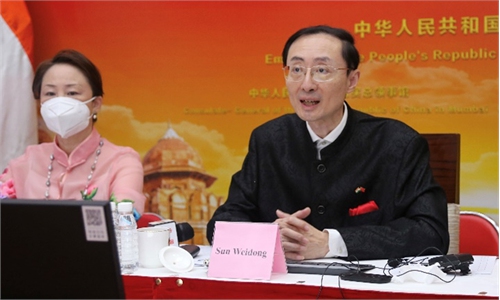
Illustration: Chen Xia/Global Times
India will for the first time export green energy from 2025, with the first shipments going to a Singapore power plant under a memorandum of understanding (MOU) that explores opportunities in green hydrogen potential in India, India's the Economic Times reported on Tuesday.India's announcement that it aims to reach net zero emissions by 2070 and switch 50 percent of its electricity demand to non-fossil energy sources by 2030 has stimulated the development of the country's green-energy industry. India's renewables sector is booming, despite multiple challenges the industry faces. Its transition to clean energy offers a huge opportunity for the economy.
There has been an increase in investment in Indian green energy projects. For instance, Indian billionaire Gautam Adani plans to invest more than $50 billion in the green hydrogen value chain and has attracted French oil major TotalEnergies SE as an investor in the business, according to Bloomberg. When rapid renewables growth happens, some Indian observers hope the nation can become a net exporter of energy in the future with the growth of hydrogen as a fuel.
Disappointingly, some in India are accustomed to a zero-sum mentality even though their prejudices will hinder the renewables sector's development. Billionaire Mukesh Ambani said earlier this year that India can become a "credible alternative" to China for green energy production as he outlined the details of a $10-billion investment in renewables that his company made last year, the Financial Times reported. It is regrettable to see some Indians still adopt a zero-sum mindset and treat the world's green energy transition as a zero-sum game.
A green energy transition led by major economies has created a huge market with strong demand. The global renewable energy market is expected to reach $1,500 billion by 2027 from $932.3 billion in 2022 with a compound annual growth rate of 10 percent, according to BCC Research. However, a $1,500 billion market is not our destination. How much renewable energy do we need to stop climate change? The number will be huge. The International Renewable Energy Agency estimates that 90 percent of the world's electricity can and should come from renewable energy by 2050. So obviously, the global green energy market is big enough to accommodate players from China, India and other countries at the same time.
Currently, the crisis on the fossil fuel markets is having a severe impact on the global economy, as soaring oil and gas prices drastically increase energy costs. If countries, including India, can expand clean energy production and exports, this will be good news to ease energy crisis and mange inflation. In this regard, economies need to enhance cooperation and work together.
A key question is how to reduce the cost of green energies and make them more accessible, affordable, sustainable and reliable. Technology, as always, is a key driver in achieving this goal. Now, China has taken a lead in renewable energy, which is being driven by technological change and the falling cost of renewables. For energy-hungry countries like India and China, they have common ground upon which they should strengthen cooperation in the field of energy efficiency, renewable energy and clean energy technologies.
The world's major emerging market economies - including China, India, and several others - are moving to the center stage of global clean energy transition. These countries should coordinate efforts on renewable energy and such cooperation will accelerate their respective green development.
The author is a reporter with the Global Times. bizopinion@globaltimes.com.cn



